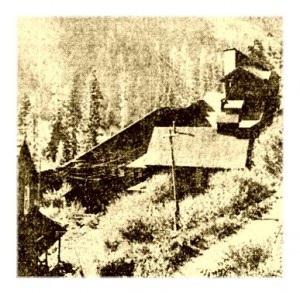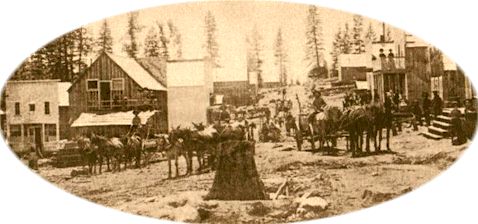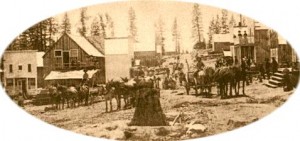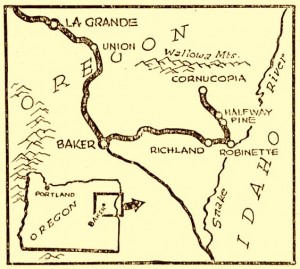Gold was first discovered near the Idaho border in eastern Oregon in 1884 by Lon Simmons. The town of Cornucopia, which in Latin means “Horn of Plenty”, sprung up – said to have been named after the mining town of Cornucopia, Nevada. In July of 1885 five hundred men had already converged on Cornucopia, “quite a village”, reported the Morning Oregonian:
There is no doubt about the mines. They are very rich. Gold is being brought in every day and to see the rock is to be convinced that the mines are a big thing.1
Miners reported veins so rich that big nuggets would tumble right out of the rocks. Over the years sixteen mines produced 300,000 ounces of gold, although one source estimates that eighty percent of the gold ore body still remains.2
 The early years from 1884 to 1886 produced the biggest gold booms, the town expanding with general stores, saloons, restaurants and hotels. However, unlike many other western mining towns, Cornucopia was a fairly tame place it seems with only a few killings (and suicides).
The early years from 1884 to 1886 produced the biggest gold booms, the town expanding with general stores, saloons, restaurants and hotels. However, unlike many other western mining towns, Cornucopia was a fairly tame place it seems with only a few killings (and suicides).
Cornucopia was situated in a mountain valley and known for its extremely harsh winters. During the winter of 1931-1932 one resident had kept meticulous records, indicating that by early March of 1932 over twenty-eight feet of snow had fallen. Massive slides were most common in the month of March as the snows began to melt.
In February of 1916 a snow slide buried a bunk house, but no injuries were reported after occupants were dug out. In January of 1923 a mother and her two children were killed when snow slide buried their home. The woman’s husband was thrown against a hot stove but survived.
The steep terrain required the use of aerial tramways and mining operations continued during the winter as weather permitted. You can find historic photos of the town and its epic snowstorms here.
Over the years fortunes of the mining operations rose and fell as the company went bankrupt, was sold, revived – and then repeated the cycle over again several times. In 1902, “the Cornucopia group of gold mines contains what is probably the largest ore body in the Pacific Northwest, if not in the United States”, according to the one newspaper.3
In the early 1900’s as many as seven hundred men were employed by the mining company. At its peak the mines were considered the sixth largest operation in the nation. Following yet another “fire sale” in early 1915, another gold strike was discovered in November. One newspaper made the following prediction:
The recent gold strikes in Cornucopia district, Baker county, have started a regular old fashioned rush to that old camp. The whole country is being staked out and some very rich ore is being uncovered. Some day a shaft or tunnel deep into old Greenhorn mountain on the line between Baker and Grant counties, is going to open up ore bodies that will make the old Comstock look to its laurels.4
In late 1921 a “lost vein” was discovered and the following year electricity was available and a twenty-stamp mill constructed, capable of producing up to sixty tons of ore per day.5 The mining company was again sold in early 1929, followed by rapid redevelopment. Then, of course, came the crash of 1929.
 The 1930 census enumerated only ten people in Cornucopia, but by 1934 mining operations were starting up again after the decline. The following year mill tailings from cyanide-processed ore of years past was being converted into gold. In 1936 weekly wages for a workforce of between 100 and 125 miners totaled $15,000 with $8,000 per week expended for supplies.6
The 1930 census enumerated only ten people in Cornucopia, but by 1934 mining operations were starting up again after the decline. The following year mill tailings from cyanide-processed ore of years past was being converted into gold. In 1936 weekly wages for a workforce of between 100 and 125 miners totaled $15,000 with $8,000 per week expended for supplies.6
In July of 1936 all but fifteen of 175 miners struck for higher wages (one more dollar per day) and two paydays per month. By 1938 the company was touting its highest monthly profits ever – $100,000 in September of that year. 1939 was even more productive and Cornucopia mines were producing sixty-six percent of Oregon’s gold.
The 1940 census showed a significant increase in population from the last census: 10 in 1930 to 352 in 1940. Clearly, the mines were operating at peak capacity as the seventh largest operation in the United States. Despite this, operations were closed near the end of 1941. By early 1942 gold mining operations throughout the United States were ordered closed by President Roosevelt to concentrate the mining labor force on extracting war-related metals.
Following the war gold mining operations in some areas resumed, but Cornucopia was deemed a “war casualty”. The town had been largely abandoned. Today there are a few still-standing buildings and rusty machinery to see, but of course the best time to visit is during the summer.
 Did you enjoy this article? Yes? Check out Digging History Magazine. Since January 2018 new articles are published in a digital magazine (PDF) available by individual issue purchase or subscription (with three options). Most issues run between 70-85 pages, filled with articles of interest to history-lovers and genealogists — it’s all history, right? 🙂 No ads — just carefully-researched, well-written stories, complete with footnotes and sources.
Did you enjoy this article? Yes? Check out Digging History Magazine. Since January 2018 new articles are published in a digital magazine (PDF) available by individual issue purchase or subscription (with three options). Most issues run between 70-85 pages, filled with articles of interest to history-lovers and genealogists — it’s all history, right? 🙂 No ads — just carefully-researched, well-written stories, complete with footnotes and sources.
Want to know more or try out a free issue? You can download either (or both) of the January-February 2019 and March-April 2019 issues here: https://digging-history.com/free-samples/
Thanks for stopping by!
- Morning Oregonian, 20 Jul 1885, p. 3
- Oregon Gold
- Oregon Daily Journal, 10 Sep 1902, p. 5
- Daily Capital Journal, 19 Nov 1915, p. 4
- Oregon Gold
- Daily Capital Journal, 08 May 1936, p. 14



Thank you for such a great article, old towns, ghost towns, gold mining, and so much information, nicely presented with some great photos. I find this so interesting and believe that my son and I will soon be traveling over the roads to see all of
these towns and more. We have been to many such places in the United States, and find history really comes alive as you go see some of the towns or places. We also enjoy seeing the other parts of the areas around these and the old cemeteries as well.
Violet
Thank you so much for stopping by. I don’t know who started passing around the article about Cornucopia but views have been through the roof the last few days. I hope you’ll take the time to look around the rest of the site — hundreds of articles about unique and sometimes obscure events or people in history.
In 1957, went on a trip to Cornucopia with my family. Two of my great uncles were watchmen at the mine. My brothers and I spent the whole day going through old buildings and picking up gold mining shares which were spread out throughout the admin office. There were numerous core samples, which I still have. It was one of the happiest times I spent as a kid.
Great memories, eh? Thanks for stopping by!
In 1963 I took my family of 5 (3 grade school age) on a eastern Oregon ghost town tour. Our final stop was Cornucopia. It literally took my breath away. I subsequently wrote about my experiences. The following is the excerpt about Cornucopia:
“The last ghost town on this trip was Cornucopia. It’s located at 7000′ elevation in the Oregon section of the Rockies. This is next to the Eagle Cap Wilderness area. It was VERY impressive to see these mountains up close – – very rocky and very steep! The canyons were narrower than I was used to. Mining started here around 1885. Cornucopia may have been Oregon’s richest gold and silver producer. More than $1,000,000,000 was taken out before 1903! That is very surprising, because the most productive years were the 1920’s and 30’s. When we visited, there were still a few residents. Because of this, we didn’t feel comfortable doing much exploring. We didn’t realize that in the surrounding area, there were actually quite a number of old mines. In fact, years later, I found out that Oregon has the most ghost towns in the country!”
Keep up the good work!!
Frank
[email protected]
Thanks for stopping by!
I grew up right in the middle of these towns and the history..not knowing it then.This and many articles ,have been great to read ..Knowing my family and ancestors went thru all this is amazing…Thank you very much..
You are so welcome .. thanks for stopping by!
I went there with my folks in 1973 I was 10 years old
I remember lots of stuff still there.
Blacks Smith, shop, tools, and forge still there.
One of the big buildings I believe was a hotel. I remember some of the brass beds in the beds were still there in the rooms
In another building that we were in I believe may have been a restaurant because there was plates and glasses and silverware are still scattered around. I would love to go back and see it but I know it’s not gonna be the same
People steal and destroy
Great article thank you
My Great Grandfather and his family lived in Cornucopia, OR during the late 1800. Their last name was Grey. My Grandmother and most of her sibling were born there. I visited Cornucopia once back in 1985 just to get a sense of where my Grandma Hazel Etta Grey (Rolland) grew up. I very was impressed with the terrain, it was beautiful. The thing that saddened me though, was we couldn’t go into any of the buildings due to the fact that the people that still live there and supervise the grounds would let us. They claimed it was for our safety, but I felt they thought we might try to steal something like others had before. Some day I want to go back and do a video of the area for my sons since it is part of our family history.
A video would be a great way to preserve your family’s history. Thanks for stopping by!
My family homesteaded hundreds of acres in the Halfway area on Pine creek & East Pine creek – – some of the family still owns property there. My Grandfathers name was Dorse Robinson.
Awesome! Thanks so much for stopping by!
My grandfather worked there for some time in the 30’s. I have a picture of mom in 1943 at her school called the Halfway school. I’ve never been there but my older brother lives now in La Grande. Funny how the old meshes with the new.
I loved your article on this town.
Thank you!
Cristina, thanks so much for stopping by …. so glad you enjoyed the article!
I am researching a geologist who worked there in the late 30s to early 40s, Robert G. Bassett. He was there in the 1940 census with his wife Nadine. They were benefactors of our department. Earth & Space Sciences (“Geology” at Robert’s time), at University of Washington. He wanted to honor his geology advisor at University of Washington, Howard Coombs, who was involved in studying the geology at Cornucopia, I really don’t know if either of them made money on the mine(s) at Cornucopia. And I am not sure if Robert’s other advisor, Milnor Roberts (Dean of the School of Mines), was involved at Cornucopia. Any additional information you have would be great. And I would like to use your information in my history, with citation, of course. If you could send me the proper citation, thanks.